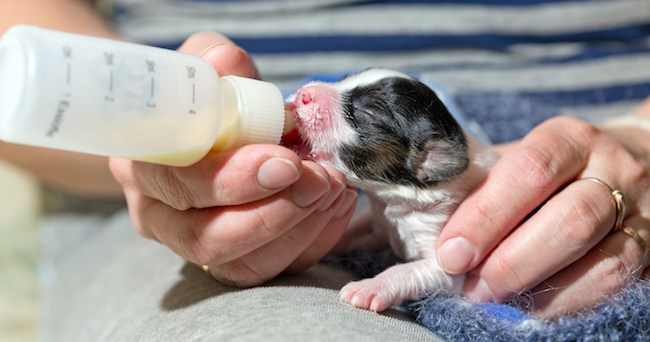
In an ideal world, a young pup or brand new kitten will get to benefit solely from the nutrition provided by their mother’s milk. But sometimes life creates unusual twists and turns, and we find ourselves caring for a small animal that may have been orphaned or abandoned, or one puppy in the litter who never seems to get enough sustenance. If that is the case, then here are some helpful tips to bear in mind when nursing a puppy or kitten.
Tips on Bottle-Feeding Pets
- First of all, if the baby has access to his or her mother, try to let nature take its course. Let them drink milk unaided. If you notice the other siblings edging one pup out of the way, keep a watch for 24 hours and see if the little one is able to eat at some point when the others are done. If they can benefit from the colostrum in the breastmilk (which fortify their immune systems) this will obviously be the best option. However, if more than 1 day goes by and you haven’t witnessed the pet feeding, it will be time to take action.
- Tools: To begin hand-feeding the pet, you will need to purchase one of these items:
- A small syringe
- A feeding bottle designed for puppies and kitties
- A premature human baby bottle
- If you are using a feeding bottle with a nipple, sterilize a needle for a few minutes, then prick two holes in the tip of the nipple, so that the liquid can ooze out. One way to test this is to tip the bottle over and see how the liquid leaves the nipple. If the milk streams out quickly it could cause the pet to sputter and choke, or even accidentally breathe in the liquid. Rather, if the milk drips out slowly, that is ideal and you can begin feeding.
- Mix the puppy or kitty formula thoroughly so it won’t be goopy and clog the syringe point or the bottle holes. See to it that the formula is neither too hot not too cold, but rather a comfortable tepid, lukewarm temperature. (A good way to test this is by letting a few drops fall on your arm or the back of your hand to sense if the temperature is correct. If the liquid burns you, let the bottle cool off in the fridge for several minutes before testing the temperature again.)
- Pet positioning is key when you start to feed. Because of the maternal instinct to cradle a puppy or cat just as one would a baby, many people try to hold the pet in a similar fashion. However, tilting them on their backs can actually cause difficulty breathing for the little creature, causing them to choke, or get fluid in their lungs (which can cause pneumonia). Avoid this by holding them on your lap, with their stomach down and their heads in an easy position (not tilted too far back) so that can feed comfortably.
- Meal times may vary based on the animal’s age or current weight. Before you begin practicing any strict routine, be sure to check with a vet who can better assess what the kitten or puppy needs. A good starting point however, is to bottle-feed the pet 5-6 times a day, when they are newborns. It is best to feed in small amounts more frequently rather than large amounts once or twice. Around 3-4 weeks into the feedings, the kitten or puppy may do well with eating 4 times a day. In between feedings hold the baby pet against you and rub their back so that they can release any air that might have gotten trapped in their tummies while they were nursing.
- If your pet is acting weak, or is cold, or seems agitated, we recommend seeing a doctor right away as he might be dehydrated, or may not be getting the nutrients he needs. The vet will be able to prescribe the right supplements, vitamins (or even an IV) to help regulate his body fluids. It is better to error on the side of asking questions rather than just assuming everything is all right. One misjudgment could result in grave danger or severe discomfort for your weak little charge.

